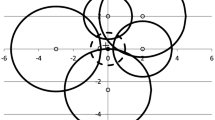Abstract
The objective of original cover location models is to cover demand within a given distance by facilities. Locating a given number of facilities to cover as much demand as possible is referred to as max-cover, and finding the minimum number of facilities required to cover all the demand is referred to as set covering. When the objective is to maximize the minimum cover of demand points, the maximin objective is equivalent to set covering because each demand point is either covered or not. The gradual (or partial) cover replaces abrupt drop from full cover to no cover by defining gradual decline in cover. Both maximizing total cover and maximizing the minimum cover are useful objectives using the gradual cover measure. In this paper we use a recently proposed rule for calculating the joint cover of a demand point by several facilities termed “directional gradual cover”. The objective is to maximize the minimum cover of demand points. The solution approaches were extensively tested on a case study of covering Orange County, California.


Similar content being viewed by others
References
Abramowitz M, Stegun I (1972) Handbook of mathematical functions. Dover Publications Inc., New York
Berman O, Krass D (2002) The generalized maximal covering location problem. Comput Oper Res 29:563–591
Berman O, Krass D, Drezner Z (2003) The gradual covering decay location problem on a network. Eur J Oper Res 151:474–480
Berman O, Drezner Z, Krass D (2010a) Cooperative cover location problems: the planar case. IIE Trans 42:232–246
Berman O, Drezner Z, Krass D (2010b) Generalized coverage: new developments in covering location models. Comput Oper Res 37:1675–1687
Berman O, Drezner Z, Krass D (2019) The multiple gradual cover location problem. J Oper Res Soc 70:931–940
Church RL, ReVelle CS (1974) The maximal covering location problem. Pap Reg Sci Assoc 32:101–118
Church RL, Roberts KL (1984) Generalized coverage models and public facility location. Pap Reg Sci Assoc 53:117–135
CPLEX, IBM ILOG (2009). V12. 1: user’s manual for CPLEX. Int Bus Mach Corp 46(53):157
Drezner T (2004) Location of casualty collection points. Environ Plan C Gov Policy 22:899–912
Drezner Z (2010) Random selection from a stream of events. Commun ACM 53:158–159
Drezner T, Drezner Z (2007) Equity models in planar location. Comput Manag Sci 4:1–16
Drezner T, Drezner Z (2014) The maximin gradual cover location problem. OR Spectr 36:903–921
Drezner Z, Wesolowsky GO, Drezner T (2004) The gradual covering problem. Nav Res Logist 51:841–855
Drezner T, Drezner Z, Salhi S (2006) A multi-objective heuristic approach for the casualty collection points location problem. J Oper Res Soc 57:727–734
Drezner T, Drezner Z, Goldstein Z (2010) A stochastic gradual cover location problem. Nav Res Logist 57:367–372
Drezner T, Drezner Z, Kalczynski P (2019) A directional approach to gradual cover. TOP 27:70–93
Eiselt HA, Marianov V (2009) Gradual location set covering with service quality. Socio-Econ Plan Sci 43:121–130
García S, Marín A (2015) Covering location problems. In: Laporte G, Nickel S, da Gama FS (eds) Location science. Springer, Heidelberg, pp 93–114
Glover F, Laguna M (1997) Tabu search. Kluwer Academic Publishers, Boston
Karasakal O, Karasakal E (2004) A maximal covering location model in the presence of partial coverage. Comput Oper Res 31:15–26
Kirkpatrick S, Gelat CD, Vecchi MP (1983) Optimization by simulated annealing. Science 220:671–680
Plastria F (2002) Continuous covering location problems. In: Drezner Z, Hamacher HW (eds) Facility location: applications and theory. Springer, Berlin, pp 39–83
ReVelle C, Toregas C, Falkson L (1976) Applications of the location set covering problem. Geogr Anal 8:65–76
Snyder LV (2011) Covering problems. In: Eiselt HA, Marianov V (eds) Foundations of location analysis. Springer, Berlin, pp 109–135
Taillard ÉD (1991) Robust tabu search for the quadratic assignment problem. Parallel Comput 17:443–455
Author information
Authors and Affiliations
Corresponding author
Additional information
Publisher's Note
Springer Nature remains neutral with regard to jurisdictional claims in published maps and institutional affiliations.
Rights and permissions
About this article
Cite this article
Drezner, T., Drezner, Z. & Kalczynski, P. Directional approach to gradual cover: a maximin objective. Comput Manag Sci 17, 121–139 (2020). https://doi.org/10.1007/s10287-019-00353-5
Received:
Accepted:
Published:
Issue Date:
DOI: https://doi.org/10.1007/s10287-019-00353-5




